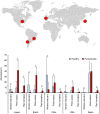Nitrate reduction capacity of the oral microbiota is impaired in periodontitis: potential implications for systemic nitric oxide availability
- PMID: 38177101
- PMCID: PMC10767001
- DOI: 10.1038/s41368-023-00266-9
Nitrate reduction capacity of the oral microbiota is impaired in periodontitis: potential implications for systemic nitric oxide availability
Erratum in
-
Publisher Correction: Nitrate reduction capacity of the oral microbiota is impaired in periodontitis: potential implications for systemic nitric oxide availability.Int J Oral Sci. 2024 Jan 26;16(1):8. doi: 10.1038/s41368-024-00283-2. Int J Oral Sci. 2024. PMID: 38272860 Free PMC article. No abstract available.
Abstract
The reduction of nitrate to nitrite by the oral microbiota has been proposed to be important for oral health and results in nitric oxide formation that can improve cardiometabolic conditions. Studies of bacterial composition in subgingival plaque suggest that nitrate-reducing bacteria are associated with periodontal health, but the impact of periodontitis on nitrate-reducing capacity (NRC) and, therefore, nitric oxide availability has not been evaluated. The current study aimed to evaluate how periodontitis affects the NRC of the oral microbiota. First, 16S rRNA sequencing data from five different countries were analyzed, revealing that nitrate-reducing bacteria were significantly lower in subgingival plaque of periodontitis patients compared with healthy individuals (P < 0.05 in all five datasets with n = 20-82 samples per dataset). Secondly, subgingival plaque, saliva, and plasma samples were obtained from 42 periodontitis patients before and after periodontal treatment. The oral NRC was determined in vitro by incubating saliva with 8 mmol/L nitrate (a concentration found in saliva after nitrate-rich vegetable intake) and compared with the NRC of 15 healthy individuals. Salivary NRC was found to be diminished in periodontal patients before treatment (P < 0.05) but recovered to healthy levels 90 days post-treatment. Additionally, the subgingival levels of nitrate-reducing bacteria increased after treatment and correlated negatively with periodontitis-associated bacteria (P < 0.01). No significant effect of periodontal treatment on the baseline saliva and plasma nitrate and nitrite levels was found, indicating that differences in the NRC may only be revealed after nitrate intake. Our results suggest that an impaired NRC in periodontitis could limit dietary nitrate-derived nitric oxide levels, and the effect on systemic health should be explored in future studies.
© 2024. The Author(s).
Conflict of interest statement
The authors declared the following potential conflicts of interest with respect to the research, authorship, and/or publication of this article: A.M. and B.T. Rosier are coinventors in a pending patent application owned by the FISABIO Institute, which protects the use of nitrate as a prebiotic and certain nitrate-reducing bacteria as probiotics. The remaining authors declare no competing interests.
Figures





References
-
- Theilade E. The non-specific theory in microbial etiology of inflammatory periodontal diseases. J. Clin. Periodontol. 1986;13:905–911. - PubMed
-
- Rosier BT, Marsh PD, Mira A. Resilience of the oral microbiota in health: mechanisms that prevent dysbiosis. J. Dent. Res. 2018;97:371–380. - PubMed
-
- Marsh PD. Are dental diseases examples of ecological catastrophes? Microbiology. 2003;149:279–294. - PubMed
-
- Mira A, Simon-Soro A, Curtis MA. Role of microbial communities in the pathogenesis of periodontal diseases and caries. J. Clin. Periodontol. 2017;44:S23–S38. - PubMed
-
- Feres M, Retamal-Valdes B, Gonçalves C, Cristina Figueiredo L, Teles F. Did Omics change periodontal therapy? Periodontol 2000. 2021;85:182–209. - PubMed
Publication types
MeSH terms
Substances
Associated data
LinkOut - more resources
Full Text Sources
Molecular Biology Databases

